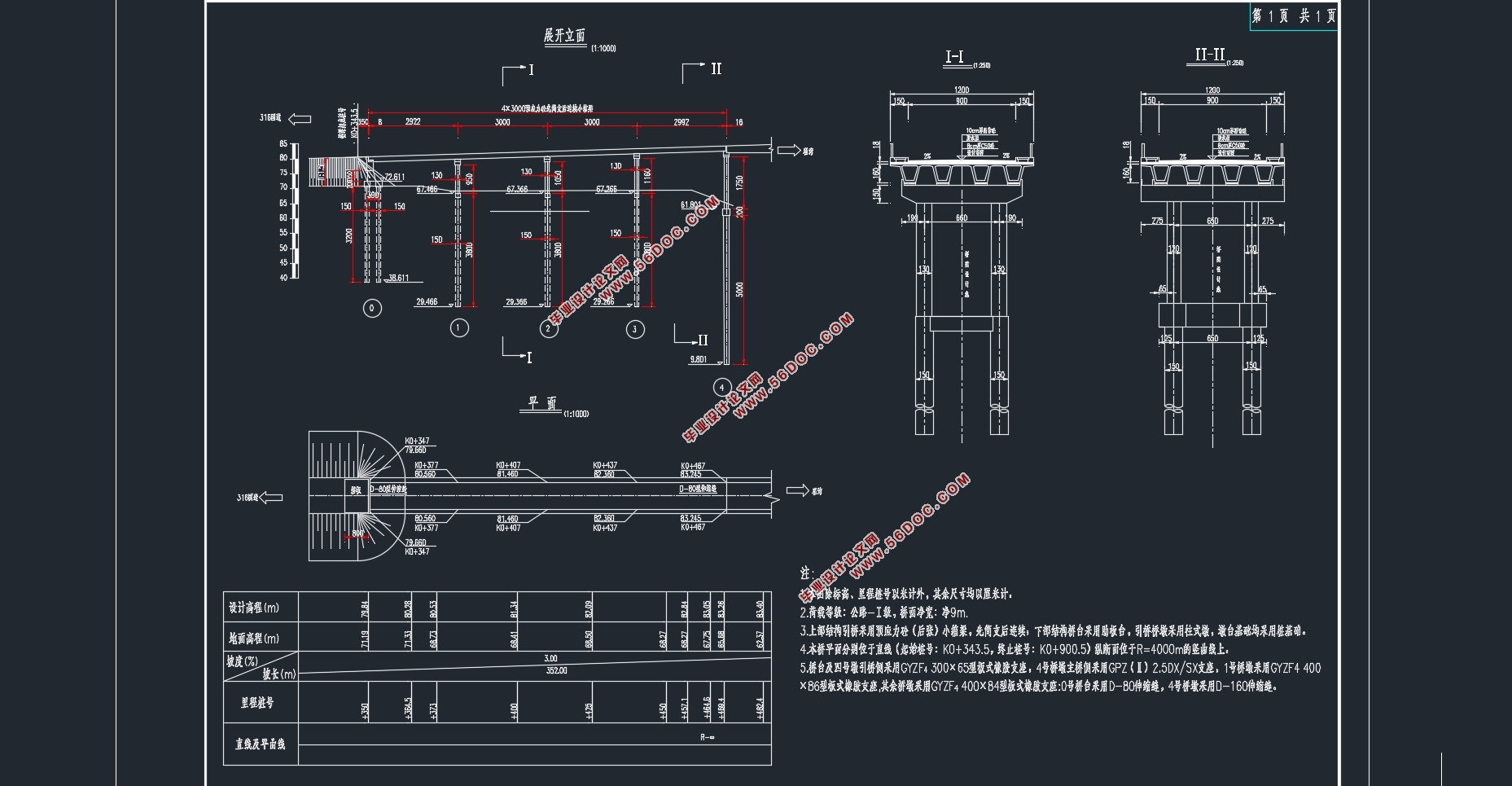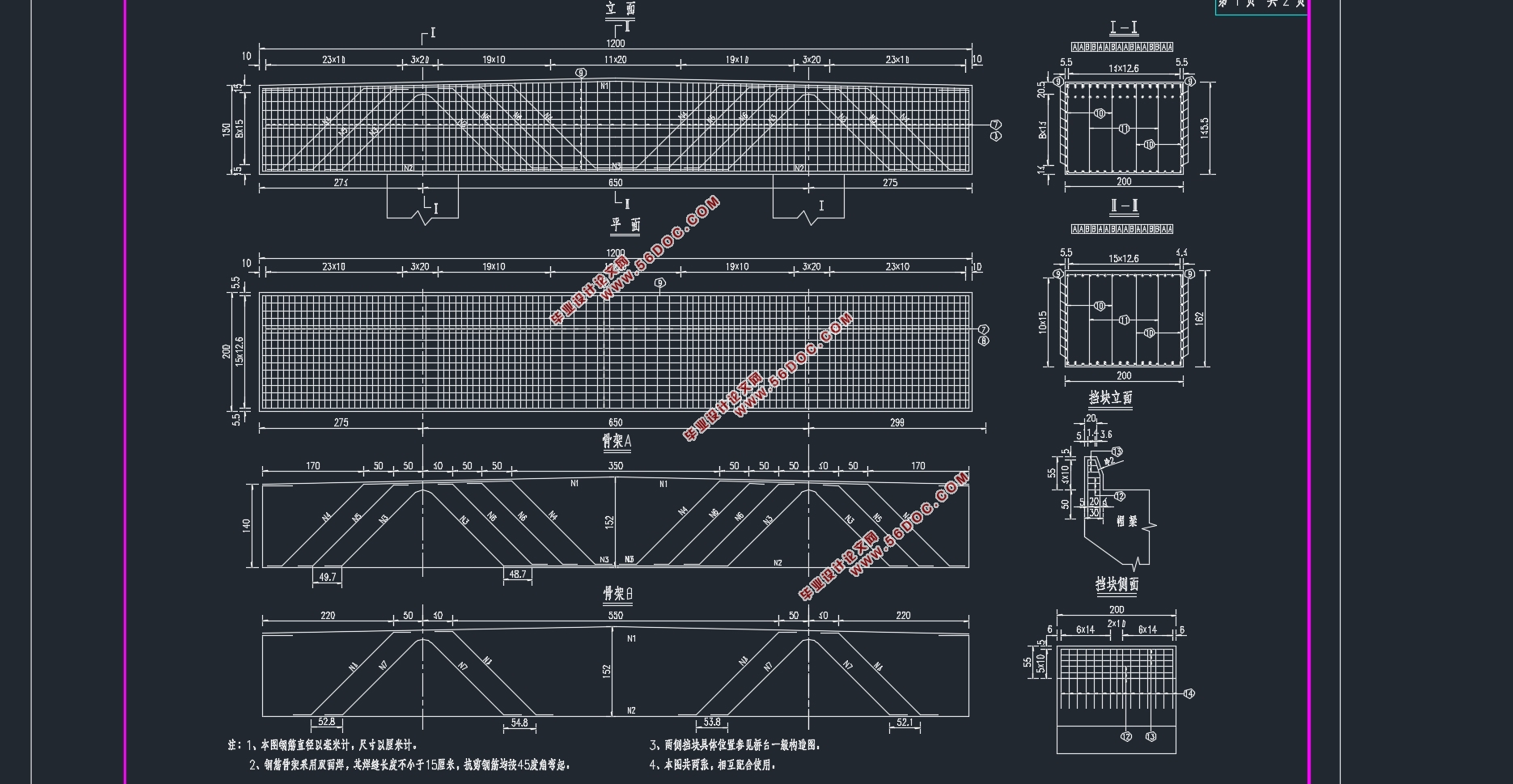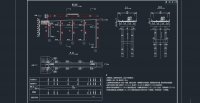4×30m预应力混凝土先简支后结构连续箱梁桥施工图设计(含CAD图)(论文说明书21000字,CAD图11张)
摘 要
本毕业设计题目为4×30m预应力混凝土先简支后结构连续箱梁桥施工图设计,是以襄阳市唐河大桥中实际项目为背景,属于该项目引桥的第一联的上部结构和下部结构计算书。预应力混凝土连续小箱梁具有施工简单,行车平顺舒,抗震能力强,易于保养和维护的特点。适用于中小跨径的桥梁。受时间及个人能力的限制,本次毕业设计未进行横向预应力、竖向预应力以及抗震的设计。
本次设计首先根据规范要求和设计经验拟定了主梁的主要构造和相关细部的尺寸,考虑到桥梁结构形式与地质条件,桥台采用肋板台,桥墩选用圆柱墩,基础均选用摩擦桩。并确定施工方式为预制吊装施工。
其次利用MIDAS 软件进行上部结构计算分析,包括内力分析,计算配筋结果,进行施工阶段及截面验算。同时必须考虑混凝土收缩、徐变次内力和地基不均匀沉降引起的次内力以及温度次内力等因素的影响。行车道板、锚下局部应力与下部结构采用手算的方式,下部结构主要进行桥墩、桥台以及桩基础的设计与计算。
经过分析计算表明,本次设计桥梁内力分布合理,并符合相应规范要求。
关键词:先简支后结构连续;结构分析;MIDAS/CIVIL
Abstract
The design of the construction of the continuous box girder bridge with 4 × 30m prestressed concrete is the background of the actual project of the Tanghe River Bridge in Xiangyang City. It belongs to the superstructure and the lower part of the first joint of the project Structure calculation book. Prestressed concrete continuous small box girder has the characteristics of simple construction, smooth driving, strong earthquake resistance, easy maintenance and maintenance. Suitable for small and medium span bridges. Due to the limitation of time and individual ability, this graduation design has not been designed for lateral prestress, vertical prestress and earthquake resistance.
In this design, the main structure and the relevant detail of the main girder are designed according to the requirements and design experience. Taking into account the bridge structure form and geological conditions, the abutment adopts the pylon table and the pier piers, and the foundation adopts the friction pile. And to determine the construction method for prefabricated lifting construction.
Second, the use of MIDAS software for the calculation of the upper structure analysis, including internal force analysis, calculation of reinforcement results, the construction phase and cross-section check. At the same time, it is necessary to consider the influence of the factors such as the shrinkage of the concrete, the internal force of the creep and the sub-internal force caused by the uneven settlement of the foundation and the internal force of the temperature. The design and calculation of the piers, abutment and pile foundation are mainly carried out by the lower part of the roadway, the local stress and the lower structure of the roadway.
After analysis and calculation shows that the design of the bridge internal force distribution is reasonable, and meet the corresponding regulatory requirements.
Key words: simple post - simple structure; structural analysis; MIDAS / CIVIL
Key words: rigid frame-continuous combination beam bridge; cantilever construction method;
MIDAS/CIVIL; structural analysis
设计方案
拟定的三个桥型方案:
方案一:4×30m预应力混凝土先简支后结构连续小箱梁桥,全长120m;
方案二:4×30m预应力混凝土先简支后结构连续T梁桥,全长120m;
方案三:35+50+35预应力混凝土变高度连续箱梁桥,全长120m。
2.3.1 预应力混凝土先简支后结构连续小箱梁桥
1)孔径布置4×30m,全长120m,宽12m。桥面设有2%的横坡,其外侧标高低于中间标高。
2)主梁结构:全桥面采用等截面箱梁,顶板厚度180cm、底板厚度25cm、翼缘根部45cm、翼缘端部厚度22cm,边梁宽度2.85m,中梁宽度2.4m,两箱梁之间设0.5m湿接缝使结构连接成整体。每跨设有4片箱梁,全桥共16片箱梁。
3)采用双圆柱式桥墩;桩基础(转孔灌注桩)。
4)施工方案:采用装配式施工方法,先简支后结构连续。
5)装配式连续箱梁桥的发展:
2.3.2 装配式预应力混凝土简支T梁
3)下部结构:采用双圆柱式桥墩;桩基础(钻孔灌注桩)。
4)施工方案:采用装配式施工法。
5)装配式预应力混凝土简支T 梁的发展:
2.3.3 预应力混凝土变高度连续箱梁桥
1)孔径布置:35m+50m+35m,全长120m,宽12m。桥面设有1.5 %的横坡,其中间标高高于外侧标高。
2)主梁结构:上部结构为预应力变高度连续箱梁。采用单箱单室形式,支点处箱梁高4m,跨中处箱梁高2m。主要采用高强混凝土以及大吨位预应力体系来实现主梁的轻型化。
3)下部结构:采用双圆柱桥墩;桩基础(钻孔灌注桩)。
4)施工方案:全桥采用预制吊装施工。
5)预应力混凝土变截面连续梁桥发展概况:



目 录
摘 要 I
Abstract II
第1章 绪论 5
1.1 预应力混凝土连续梁桥的发展概述 5
1.2 选题设计思想及意义 5
第2章 桥型方案比选 6
2.1 构思宗旨 6
2.2 比选原则 6
2.3 设计方案 6
2.3.1 预应力混凝土先简支后结构连续小箱梁桥 6
2.3.2 装配式预应力混凝土简支T梁 7
2.3.3 预应力混凝土变高度连续箱梁桥 7
第3章 桥跨总体布置及结构尺寸拟定 9
3.1 桥跨布置 9
3.2 上部结构尺寸拟定 9
3.2.1 顺桥向主梁尺寸拟定 10
3.2.2 横桥向主梁尺寸 10
3.3 下部结构尺寸的拟定 10
3.3.1 墩身尺寸拟定 10
3.3.2 桥台拟定 10
3.3.3 桩基础尺寸拟定 11
第4章 建模 11
4.1 模型简化 12
4.1.1 横向分布系数的计算 12
4.1.2 模型简化 12
4.2 主要参数说明 13
4.2.1 材料参数 13
4.2.2 荷载参数 14
4.2.3 边界说明 15
4.3 施工阶段说明 15
第5章 桥梁结构内力计算 15
5.1 恒载内力 16
5.2 活载内力 20
第6章 预应力钢筋设计及预应力损失计算 24
6.1 预应力钢筋设计 24
6.1.1 纵向预应力筋估算 24
6.1.2 预应力筋的布置 28
6.2 预应力损失 28
6.2.1 预应力钢筋与管道壁之间的摩擦 28
6.2.2 锚具变形、钢筋回缩和接缝压缩 29
6.2.3 预应力钢筋与台座之间的温差 29
6.2.4 混凝土的弹性压缩 29
6.2.5 预应力钢筋的应力松弛 30
6.2.6 混凝土的收缩徐变 30
6.2.7 预应力损失计算结果 31
第7章 次内力计算及内力组合 33
7.1 温度次内力 33
7.1.1 计算依据及方法 33
7.1.2 温度次内力计算结果 34
7.2 基础不均匀沉降次内力 39
7.3 预应力次内力 41
7.4 收缩次内力 43
7.5 徐变次内力 46
7.6 内力组合 48
7.6.1 承载能力极限状态组合 48
7.6.2 正常使用极限状态组合 50
第8章 主要截面验算 53
8.1 承载能力极限状态截面验算 54
8.1.1 正截面抗弯验算 54
8.1.2 斜截面抗剪验算 56
8.2 正常使用极限状态截面验算 57
8.2.1 使用阶段正截面抗裂验算 58
8.2.2 使用阶段斜截面抗裂验算 60
8.2.3 挠度验算 61
8.3 持久状况和短暂状况构件的应力验算 62
8.3.1 使用阶段正截面压应力验算 62
8.3.2 使用阶段斜截面主压应力验算 63
8.3.3 施工阶段正截面法向应力验算 64
8.3.4 受拉区钢筋的拉应力验算 67
第9章 锚下局部承压验算 68
9.1 局部受压区尺寸要求 69
9.2 局部抗压承载力计算 70
第10章 行车道板计算 70
10.1 中间单向板计算 71
10.1.1 恒载内力 71
10.1.2 活载内力 71
10.1.3 内力组合 73
10.2 外边梁悬臂板内力计算 74
10.2.1 恒载内力 74
10.2.2 活载内力 74
10.2.3 内力组合 75
10.3 配筋设计 75
10.3.1 支点处配筋 76
10.3.2 跨中配筋 76
第11章 桥墩计算 77
11.1 荷载计算 77
11.2 截面配筋计算 78
11.3 墩柱截面承载力验算 80
第12章 桥墩钻孔灌注桩计算 80
12.1 荷载计算 81
12.2 桩长计算 81
12.3 桩的内力及位移计算 83
12.3.1 基本假定 83
12.3.2 桩的计算宽度 83
12.3.3 桩的变形系数 83
12.3.4 计算最大冲刷线处桩身弯矩 ,水平力 及轴向力 84
12.3.5 桩身最大弯矩位置及弯矩计算 84
12.3.6 计算最大冲刷线以下深度 处桩截面上的弯矩 及水平压应力 84
12.3.7 桩顶纵向水平位移验算 87
12.4 桩身截面配筋计算 88
12.5 墩柱截面承载力验算 89
第13章 桥台计算 90
13.1 盖梁计算 91
13.1.1 计算模型 91
13.1.2 盖梁截面配筋 92
13.1.3 盖梁截面承载力验算 93
13.2 钻孔灌注桩 96
第14章 简支转连续端部浇筑顺序的探讨 96
14.1 几种可能的施工顺序与评判标准 96
14.2 计算结果与分析 97
14.2.1 跨中挠度的分析 97
14.2.2 跨中弯矩的分析 97
14.2.3 跨中内力分析 97
14.2.4 连续端内力分析 98
14.2.5 连续端弯矩分析 98
14.3 结论 99
参考文献 99
致 谢 101
|







